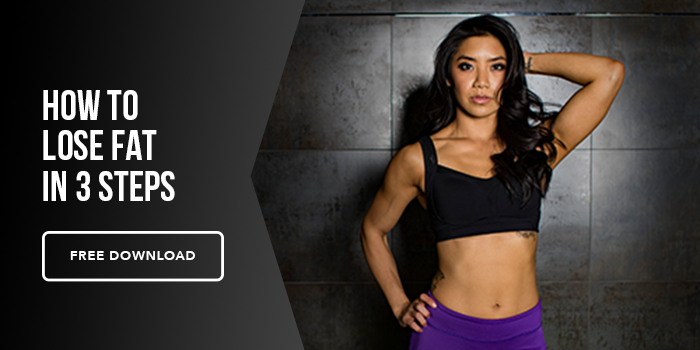Exercise, or “working out”, is usually done for a specific purpose. Only the most “enlightened” fitness enthusiasts work out for the sake of working out. Most people have a goal or a reason. Although that reason can vary dramatically from person to person, the most common general goal is fat loss.
There are a few things that need to happen in order for your body to burn fat. Your body doesn’t just remove fat without good reason. Keep in mind that the body views fat as stored energy. This stored energy is considered valuable to your body because it’s a safeguard against starvation. Remember that for the vast majority of human existence, food has been a very difficult thing to obtain. Starvation or malnutrition was one of the leading causes of death for all humans for a LONG TIME. In other words, your body won’t burn fat unless it has to.
The first step to lose fat is to create an energy imbalance. You have to take in less energy (calories) than you burn, or to put it another way, you have to burn more energy than you take in. There are two sides to this equation: the calories you eat on one side and the calories you burn on the other. This isn’t rocket science, and most people have a vague understanding of this fact. But, since fat loss is what most people workout for, you’ll commonly see value assigned to workouts based solely on how many calories they burn. This makes sense when you only take energy balance into consideration. Why would you do exercises that don’t burn many calories when the whole fat loss goal is to burn more calories than you take in, right? If traditional cardio workouts burn the most calories, why not spend your evening jogging on the treadmill? Well, there are more factors we must consider.
Here is the problem: the body is far more complex than we tend to give it credit for. When your body senses an energy imbalance it begins the process of ADAPTATION. Your body is an adaptation machine. It’s constantly trying to become better at handling the stresses being thrown at it and it’s constantly trying to become better at whatever it feels is advantageous to ensure your survival. Here are a couple examples: when you expose your bare skin to the sun your skin gets damaged by the ultraviolet radiation from the sun’s rays. In order to protect you from future exposure, your body sets the wheels in motion for adaptation. Your skin gets darker. Another example is how the skin of your hands toughens when you continuously handle rough objects. Now, let’s see how this adaptation is relevant to fat loss.
When your body is in a consistent negative energy imbalance (you are burning more than you are eating) it starts adapting by trying to SLOW your metabolism down. This process is known as metabolic adaptation and it’s incredibly effective. It does this through a complex multi-pronged process, but one of the main ways it slows down its calorie burn is to REDUCE muscle mass. In extreme cases (prisoners of war) people have been able to survive off of only hundreds of calories a day, but they were left with weak bodies devoid of muscle mass. You need to prevent this from happening or your body will stop losing fat, and you will end up with a hard progress plateau AND have a slower metabolism. Not good.
Traditional cardio (jogging, elliptical, biking, etc.) does burn a lot of calories, but it also sends an adaptation signal to the body. This signal says, “Become efficient at this activity.” Traditional cardio doesn’t require much muscular strength. It only requires ENDURANCE. Muscles don’t need to be big in order to have good endurance. This is why doing only traditional cardio for fat loss results in muscle loss and a metabolism slow down. Maybe you’ve experienced this yourself? You start jogging regularly to lose weight and it works, at first. But then things slow down, and progress comes to a grinding stop. Frustrating isn’t it?
Another form of cardio exists that doesn’t cause this metabolism slowdown nearly as much. It’s known as high intensity interval training or HIIT for short. With traditional cardio you move with a low to moderate intensity for a long period of time. With HIIT cardio you employ explosive sprints, making the total time spent much shorter. Traditional cardio is a long sustained 30 to 60 minute jog, while HIIT cardio would be several sprints done in sets for a total time of 10-20 minutes. HIIT cardio requires much more strength than traditional cardio does, which tells your body it NEEDS strength. The negative effects of traditional cardio are minimized when performing HIIT. However, it does have drawbacks of its own.
HIIT is a very intense form of exercise. If you’re someone who doesn’t get good sleep, is under consistent stress, or you feel like your hormones aren’t balanced, HIIT cardio would just place more stress on your body. Too much stress makes fat loss or muscle gain all but impossible. For these kinds of people, regular low intensity cardio done appropriately (it can be overdone too) can be recuperative and regenerative. Long walks or hikes fall under the category of traditional cardio, and that’s what I recommend to these kinds of people.
HIIT cardio also requires a higher level of fitness and skill. Sprinting hard for short distances is NOT appropriate for beginners, whereas walking for long distances probably would be. To be honest, I only recommend HIIT cardio to people who already possess a decent level of fitness and who are otherwise balanced with their health.
Regardless of which form of cardio you choose, it’s an absolute MUST that you also lift weights or do some form of muscle building resistance training. Although resistance training burns little calories when compared to cardio, it tells the body to adapt in a way that is VERY favorable for fat loss. It tells the body to get stronger! This means more muscle and a faster metabolism. At the very least, a good resistance training program will mitigate the metabolism slowdown that can happen from a fat burning strategy.
- MPM Story
- MAPS Fitness Products
- MAPS Individual Programs
- MAPS Anabolic
- MAPS Anabolic Advanced
- MAPS Performance
- MAPS Performance Advanced
- MAPS Aesthetic
- MAPS Anywhere
- MAPS Prime
- MAPS Prime Pro
- MAPS HIIT
- MAPS Split
- MAPS Strong
- MAPS Starter
- MAPS P.E.D.
- MAPS OCR
- MAPS Powerlift
- MAPS Suspension
- MAPS Resistance
- MAPS Symmetry
- MAPS Cardio
- MAPS 15 Minutes
- MAPS Bands
- MAPS Oldtime Strength
- MAPS 40+
- MAPS Muscle Mommy
- MAPS GLP-1
- MAPS 15 Performance
- MAPS Transform
- MAPS Longevity
- MAPS 15 Muscle Mommy
- MAPS 15 Strong
- MAPS 15 Forty Plus
- MAPS 15 Powerlift
- MAPS 15 Symmetry
- MAPS MODS
- Fitness Bundles
- Starter Bundle
- Home Workout Warrior Bundle
- Anabolic Metabolism Bundle
- Advanced Strength Building Bundle
- Business Man Bundle
- Fit Mom Bundle
- Fabulous 40's Bundle
- EXTREME Fitness Bundle
- Bikini Bundle
- Skinny Guy Bundle
- Shredded Summer Bundle
- Build Your BUTT Bundle
- Sexy Athlete Bundle
- Prime Pro Bundle
- Couples Bundle
- RGB Bundle
- Super Bundle
- Guides
- Intermittent Fasting
- Intuitive Nutrition
- Occlusion Training
- Muscle Building Secrets of Isometrics
- Reverse Dieting 101
- VO2 Max Boost
- Eat for Performance
- Power of Sleep
- Advanced Training Techniques
- Carb Cycling Diet
- Quick Meals for Fitness & Health
- Ultimate Bodyweight Training
- Forgotten Muscle & Strength Building Secrets
- Ultimate Medication Guide for Patients & Healthcare Professionals
- MAPS Transformation Diet Guide
- Additional Fitness Programs
- MAPS Individual Programs
- Shop
- Free Resources
- Blog
- Podcast
- Contact Us
- MP Fitness Coaching
- Login





